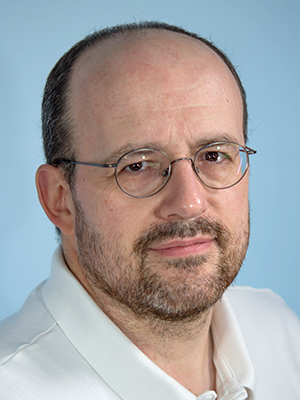NICHD Microscopy and Imaging Core

- Vincent Schram, PhD, Acting Executive Director, Staff Scientist
- Tamás Balla, MD, PhD, Scientific Advisor and Administrative Director
- Ling Yi, PhD, Staff Scientist
- Louis (Chip) Dye, BS, Research Assistant
- Lynne A. Holtzclaw, BS, Research Assistant
- Sara E. Felsen, MS, Intramural Research Training Award Fellow
The mission of the NICHD Microscopy and Imaging Core (MIC) is to provide service in four different areas: (1) histology and sample preparation for light and electron microscopy; (2) wide-field and confocal light microscopy; (3) transmission electron microscopy (TEM); and (4) image analysis and data extraction. The Facility operates as a ’one-stop shop,’ where investigators can, with a minimum of effort, go from their scientific question to the final data.
Although they were scaled back in June 2021, the MIC staff and its users continue to be affected by COVID–related NIH restrictions on physical occupancy.
Mode of operation
Located on the ground floor of the Porter Building (building 35A), the MIC is accessible 24/7, and users can reserve time on each microscope by using an online calendar. The facility is available free of charge to all NICHD investigators and, resources allowing, to anyone within the Porter building. The facility is supported by the Office of the Scientific Director, NICHD. The MIC is under the joined management of Tamás Balla (scientific advisor and administrative director) and Vincent Schram (acting executive director).
Vincent Schram is the point person for light microscopy and data analysis. Following the retirement of Lynne Holtzclaw in August 2021, Ling Yi joined the MIC to head the sample-preparation/histology unit. Sara Felsen, our Intramural Research Training Award Fellow, left the MIC in August 2021. The EM branch of the Facility is staffed by Chip Dye. Ling Yi and Chip Dye report to Vincent Schram, who coordinates activities with Tamás Balla.
The MIC has an open-door policy with the NINDS Light Imaging Facility (LIF, Building 35). The two cores freely exchange users, share equipment, and trade support. Although not officially sanctioned, this mode of operation provides extended support hours, wider expertise, and access to more equipment than each Institute could afford on its own.
The MIC serves over 300 registered users in 68 laboratories. NICHD uses 80% of the facility's resources, NINDS 15%, and other Institutes (NIBIB, NIA, and NIMH) the remaining 5%.
Light microscopy
The MIC is equipped with six confocal microscopes, each optimized for certain applications:
- Zeiss LSM 710 inverted for high-resolution confocal imaging;
- Zeiss LSM 780 equipped with a spectral detector;
- a new Nikon Spinning Disk/Total Internal Reflection Fluorescence (TIRF) hybrid microscope, received in March 2021, an advanced motorized rotating module that allows for unparalleled image quality;
- Zeiss LSM 880 2-photon confocal for thick tissues and live animals;
- Zeiss 800 optimized for advanced tiling experiments;
- Zeiss 880 AiryScan with higher spatial resolution.
Additionally, the MIC operates two wide-field microscopes: a fully automated Zeiss Axioscan Z1 slide scanner that was delivered in February 2021, and an older wide-angle microscope. Both units are fully motorized and capable of fluorescence and transmission imaging on large tissue sections. The Axioscan Z1 can process up to 100 slides unattended.
After an initial orientation, during which the staff research the project and decide on the best approach, users receive hands-on training on the equipment and/or for the software best suited to their goals, followed by continuous support when required. Once image acquisition is complete, the staff devise solutions and train users on how to extract usable data from their images.
Electron microscopy
The electron microscopy branch of the Facility processes specimens from start to finish: fixation, embedding, semi-thin and ultra-thin sectioning, staining, and imaging on the JEOL 1400 transmission electron microscope. Because of the labor involved, the volume is necessarily smaller than for the light microscopy branch, where end users do their own processing. In the past 12 months, Chip Dye processed a total of 110 samples for morphology studies.
Tissue preparation
Until her retirement, Lynne Holtzclaw was in charge of sample-processing training and services at the MIC. Six users were trained in person in rodent perfusion, cryopreservation, cryosectioning, and immunofluorescence. Five instances of perfusion and cryosectioning services were provided. NICHD users of the histology suite include Drs. Balla, Buonanno, Crouch, Fields, Hoffman, Le Pichon, Loh, McBain, Ozato, Pfeifer, Sackett, Stojilkovic, and Stopfer. Users from other Institutes include Drs. Mario Penzo (NIMH), Dietmar Plenz (NIMH), and Mark Cookson (NIA).
We pursued a collaborative effort with Robert Crouch to investigate developmental cerebellar protein expression disruptions. We concluded RNAScope experiments for a collaborative project with David Klein with the assistance of Sara Felsen. These experiments targeted important developmental genes in the rat pineal gland and corroborated RNASeq data from pineal glands.
Ying Yi took over the sample preparation branch in September 2021.
Image analysis
High-end computer workstations with imaging software (Zeiss Zen, Nikon Element, Bitplane Imaris, SVI Hyugens, and ImageJ) are available at the MIC.
Image processing based on neural networks (Artificial Intelligence or AI) is a remarkably powerful tool for image restoration, segmentation, and resolution improvement. The MIC is actively looking at AI–powered solutions for image restoration and segmentation. The Nikon NIS-AI suite, an advanced software for noise removal and segmentation not possible with conventional methods, is available in the Core.
Collaborators
- Robert J. Crouch, PhD, Section on Formation of RNA, NICHD, Bethesda, MD
- David C. Klein, PhD, Scientist Emeritus, NICHD, Bethesda, MD
- Carolyn L. Smith, PhD, Light Imaging Facility, NINDS, Bethesda, MD
Contact
For more information, email schramv@mail.nih.gov or visit https://mic.nichd.nih.gov.


